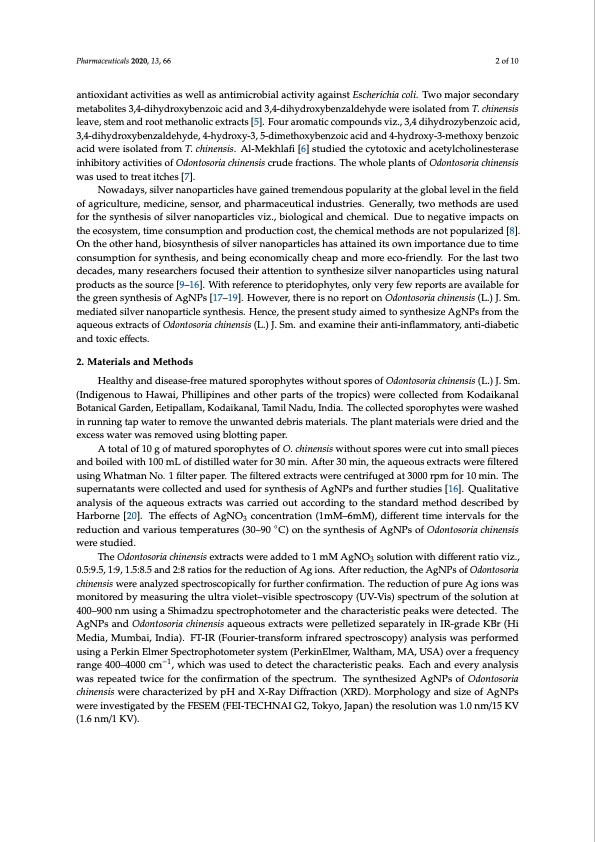
PDF Publication Title:
Text from PDF Page: 002
Pharmaceuticals 2020, 13, 66 2 of 10 antioxidant activities as well as antimicrobial activity against Escherichia coli. Two major secondary metabolites 3,4-dihydroxybenzoic acid and 3,4-dihydroxybenzaldehyde were isolated from T. chinensis leave, stem and root methanolic extracts [5]. Four aromatic compounds viz., 3,4 dihydrozybenzoic acid, 3,4-dihydroxybenzaldehyde, 4-hydroxy-3, 5-dimethoxybenzoic acid and 4-hydroxy-3-methoxy benzoic acid were isolated from T. chinensis. Al-Mekhlafi [6] studied the cytotoxic and acetylcholinesterase inhibitory activities of Odontosoria chinensis crude fractions. The whole plants of Odontosoria chinensis was used to treat itches [7]. Nowadays, silver nanoparticles have gained tremendous popularity at the global level in the field of agriculture, medicine, sensor, and pharmaceutical industries. Generally, two methods are used for the synthesis of silver nanoparticles viz., biological and chemical. Due to negative impacts on the ecosystem, time consumption and production cost, the chemical methods are not popularized [8]. On the other hand, biosynthesis of silver nanoparticles has attained its own importance due to time consumption for synthesis, and being economically cheap and more eco-friendly. For the last two decades, many researchers focused their attention to synthesize silver nanoparticles using natural products as the source [9–16]. With reference to pteridophytes, only very few reports are available for the green synthesis of AgNPs [17–19]. However, there is no report on Odontosoria chinensis (L.) J. Sm. mediated silver nanoparticle synthesis. Hence, the present study aimed to synthesize AgNPs from the aqueous extracts of Odontosoria chinensis (L.) J. Sm. and examine their anti-inflammatory, anti-diabetic and toxic effects. 2. Materials and Methods Healthy and disease-free matured sporophytes without spores of Odontosoria chinensis (L.) J. Sm. (Indigenous to Hawai, Phillipines and other parts of the tropics) were collected from Kodaikanal Botanical Garden, Eetipallam, Kodaikanal, Tamil Nadu, India. The collected sporophytes were washed in running tap water to remove the unwanted debris materials. The plant materials were dried and the excess water was removed using blotting paper. A total of 10 g of matured sporophytes of O. chinensis without spores were cut into small pieces and boiled with 100 mL of distilled water for 30 min. After 30 min, the aqueous extracts were filtered using Whatman No. 1 filter paper. The filtered extracts were centrifuged at 3000 rpm for 10 min. The supernatants were collected and used for synthesis of AgNPs and further studies [16]. Qualitative analysis of the aqueous extracts was carried out according to the standard method described by Harborne [20]. The effects of AgNO3 concentration (1mM–6mM), different time intervals for the reduction and various temperatures (30–90 ◦C) on the synthesis of AgNPs of Odontosoria chinensis were studied. The Odontosoria chinensis extracts were added to 1 mM AgNO3 solution with different ratio viz., 0.5:9.5, 1:9, 1.5:8.5 and 2:8 ratios for the reduction of Ag ions. After reduction, the AgNPs of Odontosoria chinensis were analyzed spectroscopically for further confirmation. The reduction of pure Ag ions was monitored by measuring the ultra violet–visible spectroscopy (UV-Vis) spectrum of the solution at 400–900 nm using a Shimadzu spectrophotometer and the characteristic peaks were detected. The AgNPs and Odontosoria chinensis aqueous extracts were pelletized separately in IR-grade KBr (Hi Media, Mumbai, India). FT-IR (Fourier-transform infrared spectroscopy) analysis was performed using a Perkin Elmer Spectrophotometer system (PerkinElmer, Waltham, MA, USA) over a frequency range 400–4000 cm−1, which was used to detect the characteristic peaks. Each and every analysis was repeated twice for the confirmation of the spectrum. The synthesized AgNPs of Odontosoria chinensis were characterized by pH and X-Ray Diffraction (XRD). Morphology and size of AgNPs were investigated by the FESEM (FEI-TECHNAI G2, Tokyo, Japan) the resolution was 1.0 nm/15 KV (1.6 nm/1 KV).PDF Image | Synthesis of Silver Nanoparticles Using Odontosoria chinensis

PDF Search Title:
Synthesis of Silver Nanoparticles Using Odontosoria chinensisOriginal File Name Searched:
pharmaceuticals-13-00066-v2.pdfDIY PDF Search: Google It | Yahoo | Bing
Turbine and System Plans CAD CAM: Special for this month, any plans are $10,000 for complete Cad/Cam blueprints. License is for one build. Try before you buy a production license. More Info
Waste Heat Power Technology: Organic Rankine Cycle uses waste heat to make electricity, shaft horsepower and cooling. More Info
All Turbine and System Products: Infinity Turbine ORD systems, turbine generator sets, build plans and more to use your waste heat from 30C to 100C. More Info
CO2 Phase Change Demonstrator: CO2 goes supercritical at 30 C. This is a experimental platform which you can use to demonstrate phase change with low heat. Includes integration area for small CO2 turbine, static generator, and more. This can also be used for a GTL Gas to Liquids experimental platform. More Info
Introducing the Infinity Turbine Products Infinity Turbine develops and builds systems for making power from waste heat. It also is working on innovative strategies for storing, making, and deploying energy. More Info
Need Strategy? Use our Consulting and analyst services Infinity Turbine LLC is pleased to announce its consulting and analyst services. We have worked in the renewable energy industry as a researcher, developing sales and markets, along with may inventions and innovations. More Info
Made in USA with Global Energy Millennial Web Engine These pages were made with the Global Energy Web PDF Engine using Filemaker (Claris) software.
Infinity Turbine Developing Spinning Disc Reactor SDR or Spinning Disc Reactors reduce processing time for liquid production of Silver Nanoparticles.
| CONTACT TEL: 608-238-6001 Email: greg@infinityturbine.com | RSS | AMP |